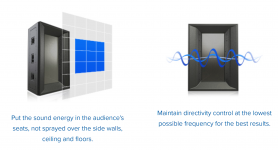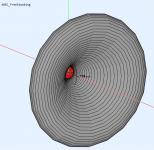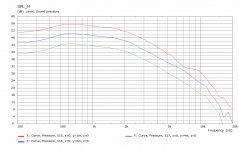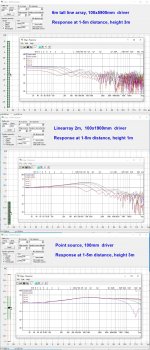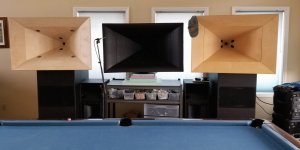To help make it more clear I'll repeat the information from post 20. Notice it is expanding surface area that matters. Also, pretend the goal is to maximize attenuation.
The maximum amount of attenuation you can achieve is an omnidirectional point source radiating into a sphere, which is -6dB. If you radiate into a surface area less than a sphere -- a spherical cap -- you can't achieve -6dB.
The maximum amount of attenuation you can achieve is an omnidirectional point source radiating into a sphere, which is -6dB. If you radiate into a surface area less than a sphere -- a spherical cap -- you can't achieve -6dB.
"As sound waves travel farther from their source, the more spread out their energy becomes. You can see how this works in the Figure below. As distance from the sound source increases, the area covered by the sound waves increases. The same amount of energy is spread over a greater area, so the intensity and loudness of the sound is less. This explains why even loud sounds fade away as you move farther from the source."
CK12-Foundation
you can't achieve -6dB
You can, it will just be louder than if it were radiating full sphere, but it still drops off at the same rate as the sphere.
Like the text in your quote explains in clear language.
You can sim this, measure it and even calculate it. But it isn't advised to fantasize about it.
wesayso referenced Danley's FAQ. What does it say?
A point source is omnidirectional radiating into the surface area of a sphere. The line array is directional on the vertical and radiates into the surface area of a cylinder.
Sphere = 6dB
Cylinder = 3dB
Danley continues on about the array.
We've already discussed how arrays control frequencies at a fraction of their length. Thus, there's nothing new in that FAQ that we haven't already covered.
Point Sources.
A point source loudspeaker will generally drop off at a rate of 6dB every time you double the distance.
Line Arrays.
It is often stated that line arrays only drop off at a rate of 3dB whenever you double the distance from them.
A point source is omnidirectional radiating into the surface area of a sphere. The line array is directional on the vertical and radiates into the surface area of a cylinder.
Sphere = 6dB
Cylinder = 3dB
Danley continues on about the array.
This is only partially true. It is true as long as the line is long enough in relation to the particular freq that this will happen. For the high freq this does happen (with lots of interference along the way). But with low freq-unless the line is very large-it will drop off at a rate of 6dB-just like a point source. So with those types of devices, you have to be specific about the freq of interest when stating loss over distance.
We've already discussed how arrays control frequencies at a fraction of their length. Thus, there's nothing new in that FAQ that we haven't already covered.
Attachments
You can, it will just be louder than if it were radiating full sphere, but it still drops off at the same rate as the sphere.
Like the text in your quote explains in clear language.
You can sim this, measure it and even calculate it. But it isn't advised to fantasize about it.
Neat. I don't know how to use sim software. Sure would be good to see an omnidirectional point source simmed against a directional source over distance in the frequency range controlled by the horn (not the longer frequencies that radiate omnidirectionally).
Danley's designs are point source, basically all of them in his catalog. If you don't tryst me, just ask him. One of his representatives will surely tell you if you ask that question on Facebook. Danly doesn't do line arrays, even his SBH series that looks like a line, still is a point source. As that one is limiting the vertical behavior, it may act a little different in nearfield conditions.
The horns are acting as a point source though, just check with his firm on Facebook or through email. If they answer, I hope you will believe their word for it.
The horns are acting as a point source though, just check with his firm on Facebook or through email. If they answer, I hope you will believe their word for it.
To help make it more clear I'll repeat the information from post 20. Notice it is expanding surface area that matters. Also, pretend the goal is to maximize attenuation.
The maximum amount of attenuation you can achieve is an omnidirectional point source radiating into a sphere, which is -6dB. If you radiate into a surface area less than a sphere -- a spherical cap -- you can't achieve -6dB.
Maths to rescue
area of the spherical cap, using distance r from the center ( point source ).
A = 2*pi*r^2*(1- cos(the angle)). Area of the spherical cap depends on the distance r squared, just like with a sphere, no matter what the angle.
Area of sphere is calculated as so, Area is connected to the r squared.
A = 4*pi*r^2
Surface area of a tube, a line source, at given distance r is calculated like so
A = 2*pi*r*h
You see it is directly proportional to the distance, not squared as with the sphere and spherical cap.
Sure would be good to see an omnidirectional point source simmed against a directional source over distance in the frequency range controlled by the horn (not the longer frequencies that radiate omnidirectionally).
To add to the mathematical explanation above
Here is a horn in a BEM simulation with the output at 1m, 2m and 4m
Attachments
Line arrays don't radiate as tubes IRL. Distance variation will introduce diffraction variation which is also frequency-dependent.
At very long distance, air friction will tame high frequencies more than lows. This effect is not noticed at home (overruled by effect of typically narrower radiation)
The Edge simulations don't show spl drop based on mic distance, only interferences.Here 2m vs. 6m tall arrays
At very long distance, air friction will tame high frequencies more than lows. This effect is not noticed at home (overruled by effect of typically narrower radiation)
The Edge simulations don't show spl drop based on mic distance, only interferences.Here 2m vs. 6m tall arrays
Attachments
Last edited:
Jeah measurements show whats happening more easily than trying to tackle the situation with maths. Maths get complicated the moment one realizes sound isn't radiating from single point in space, or from a perfect line and then there is the environment.
There was some confusion how much sphere and spherical cap area expands in relation to the distance from the center, they expand as much, doubling distance quadruples the area.
There was some confusion how much sphere and spherical cap area expands in relation to the distance from the center, they expand as much, doubling distance quadruples the area.
Ok, I'm convinced. I was wrong. Thanks to tmuikku and Fluid for the math and the simulation. The two together were good explanations.
line arrays drop off slower than 6dB/doubledistance because the target isn't in the far field. Like if you measure a cone driver close up it doesn't drop 6dB per till you get out away from the cone some distance. Make a cone 12 feet tall and measure it out 5 feet or less, the dropoff rate will be slower.
line arrays drop off slower than 6dB/doubledistance because the target isn't in the far field. Like if you measure a cone driver close up it doesn't drop 6dB per till you get out away from the cone some distance. Make a cone 12 feet tall and measure it out 5 feet or less, the dropoff rate will be slower.
Yes! Far field is defined by the distance that 6dB/doubledistance begins.
Inside that is nearfield, dominated by multiple arrivals.
Just as there is no such thing as a true point source, there is no such thing a true line source.
Which means to me, there is no such thing as a spherical or cylindrical wave front.
Theories walk, measurements talk 😉
As an add on to my prior post...
Outdoors, it's easy to measure when far field begins.
Indoors, not easy at all, as reflections/reverb often swamp measurements.
Here's maybe the best method indoor method I've come across...Direct-Field Coverage - A practical way to check it
Why i think all this is important, is because ime both our measurements and listening are best in the far field.
Outdoors, it's easy to measure when far field begins.
Indoors, not easy at all, as reflections/reverb often swamp measurements.
Here's maybe the best method indoor method I've come across...Direct-Field Coverage - A practical way to check it
Why i think all this is important, is because ime both our measurements and listening are best in the far field.
Hi
There is a way one could observe a horn in use and conclude that it did indeed defeat the inverse square law. In fact this is done fairly often by us at work in installed sound.
The basic idea comes from the olden days, a single horn projects a lobe and if one raises the height of the horn and aims it at the back row, one makes the spl much more uniform front to back than a low height (on axis).
This reduces the difference in distance between the front and back rows AND as you move forward to the front, you are gradually moving out of the lobe.
This can't be done as well when one has multiple sources which produce both lobes and nulls or even that well with traditional horns which get narrower as the frequency climbs. But was "the way" pro's did it and the same principal is why one toes in speakers (aim at the far seat)
What the Synergy horn does is give one a way to make a much wider bandwidth high power horn that still radiates simply as if it were one source in one CD horn. It can do this because all the sources are less than 1/4 wl apart where they interact or combine resulting in coherent addition (like two very close together subwoofers do but inside of the horn).
To the degree one can also make it a "constant directivity" horn, then one finds that as one moves out of the pattern, the SPL still falls but unlike "not CD" horns that narrow up high, the spectrum stays much more constant off axis than normal.
By choosing a large horn with the right pattern angles and aim point, it is possible to get even sports stadiums to + - 2dB level in every seat and the comment "it sounds the same everywhere" has even been heard.
If you have heard any of the recordings like the fireworks I have made with a microphone experiment, it would not be a surprise to learn how we hear and the capture and reproduction of the "image" is a long time interest of mine.
About a year ago, I was pretty much caught up on my official "wish list" at work when the Virus and the slow down hit. I build some of our prototypes or the ones i can anyway, I like that part and it's a big part of what i love about speakers "this is how we make the sawdust" (moonshiners show reference) ending with listening and measuring haha.
I have some of the oldest SH-50's from 2005 in my living-room with sub-woofer. I thought a lot about what would i build for me when the time came, what i would want.
I like to crank it up occasionally and its part of the home theater but It doesn't have to be that powerful or large, i only sit 15 feet away but it does need to image like that or better and still be able to do the fireworks recording.
After a few months, I brought them in to work and Mike wanted to keep them in the demo room, so i made a second pair, then our wood shop made some and enough people wanted them then that it became it's own thing.
Hope that helps
Tom Danley
There is a way one could observe a horn in use and conclude that it did indeed defeat the inverse square law. In fact this is done fairly often by us at work in installed sound.
The basic idea comes from the olden days, a single horn projects a lobe and if one raises the height of the horn and aims it at the back row, one makes the spl much more uniform front to back than a low height (on axis).
This reduces the difference in distance between the front and back rows AND as you move forward to the front, you are gradually moving out of the lobe.
This can't be done as well when one has multiple sources which produce both lobes and nulls or even that well with traditional horns which get narrower as the frequency climbs. But was "the way" pro's did it and the same principal is why one toes in speakers (aim at the far seat)
What the Synergy horn does is give one a way to make a much wider bandwidth high power horn that still radiates simply as if it were one source in one CD horn. It can do this because all the sources are less than 1/4 wl apart where they interact or combine resulting in coherent addition (like two very close together subwoofers do but inside of the horn).
To the degree one can also make it a "constant directivity" horn, then one finds that as one moves out of the pattern, the SPL still falls but unlike "not CD" horns that narrow up high, the spectrum stays much more constant off axis than normal.
By choosing a large horn with the right pattern angles and aim point, it is possible to get even sports stadiums to + - 2dB level in every seat and the comment "it sounds the same everywhere" has even been heard.
If you have heard any of the recordings like the fireworks I have made with a microphone experiment, it would not be a surprise to learn how we hear and the capture and reproduction of the "image" is a long time interest of mine.
About a year ago, I was pretty much caught up on my official "wish list" at work when the Virus and the slow down hit. I build some of our prototypes or the ones i can anyway, I like that part and it's a big part of what i love about speakers "this is how we make the sawdust" (moonshiners show reference) ending with listening and measuring haha.
I have some of the oldest SH-50's from 2005 in my living-room with sub-woofer. I thought a lot about what would i build for me when the time came, what i would want.
I like to crank it up occasionally and its part of the home theater but It doesn't have to be that powerful or large, i only sit 15 feet away but it does need to image like that or better and still be able to do the fireworks recording.
After a few months, I brought them in to work and Mike wanted to keep them in the demo room, so i made a second pair, then our wood shop made some and enough people wanted them then that it became it's own thing.
Hope that helps
Tom Danley
Thank you Tom for the writeup!
Seems like you have kept up the curious boy spirit, which is one of the major driving forces in science and technology. Hyperions will raise eyebrows and smiles I'm sure of that.
Seems like you have kept up the curious boy spirit, which is one of the major driving forces in science and technology. Hyperions will raise eyebrows and smiles I'm sure of that.
Super to see you post on DIY again, Tom !
Many thanks for all the kind generous help you've given the DIY community over the years.
And Best of Luck to DSL, with the home/studio products!
That said, my next post will be speculating about the Hyperion, trying to crack it, as all we DIY'ers are known to do Lol
Many thanks for all the kind generous help you've given the DIY community over the years.
And Best of Luck to DSL, with the home/studio products!
That said, my next post will be speculating about the Hyperion, trying to crack it, as all we DIY'ers are known to do Lol
Ok, trying to guess more about the Hyperion.
I'm thinking the top section is very similar to the SM-60F...both appear to have a 5" coaxial, and two 8" drivers. We can see both mid-range ports and reflex ports for the 8 inchers.
In the lower section, I love the opposed side firing 15" sub drivers. Big time vibration reduction.
I think the reason for the feet is what appears to be incorporating a downward firing reflex port.
Whether that Hyperion sub take is correct or not, i think side-firing opposed, with downward reflex port, is a great idea.
Less volume needed than my current clamshell slot loaded subs (no slot volume needed). And the box height could make make reflex port length much easier to fit in, for going lower.
Opposed firing sub drivers are simply a must imho.
I'm thinking the top section is very similar to the SM-60F...both appear to have a 5" coaxial, and two 8" drivers. We can see both mid-range ports and reflex ports for the 8 inchers.
In the lower section, I love the opposed side firing 15" sub drivers. Big time vibration reduction.
I think the reason for the feet is what appears to be incorporating a downward firing reflex port.
Whether that Hyperion sub take is correct or not, i think side-firing opposed, with downward reflex port, is a great idea.
Less volume needed than my current clamshell slot loaded subs (no slot volume needed). And the box height could make make reflex port length much easier to fit in, for going lower.
Opposed firing sub drivers are simply a must imho.
That Hyperion is huge. Like full size refrigerator huge.
54.75 x 28.25 x 27.5 = 24.6 cubic feet.
The top section is a little smaller, so actual volume would be a bit lower.
54.75 x 28.25 x 27.5 = 24.6 cubic feet.
The top section is a little smaller, so actual volume would be a bit lower.
- Home
- Loudspeakers
- Multi-Way
- Danley Signature Series
